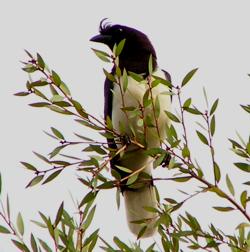
Tocantins is one of the 26 states of Brazil. It is the newest state, formed in 1988 and encompassing what had formerly been the northern two-fifths of the state of Goiás. Tocantins covers 277,620.91 square kilometres (107,190.03 sq mi) and had an estimated population of 1,496,880 in 2014. Construction of its capital, Palmas, began in 1989; most of the other cities in the state date to the Portuguese colonial period. With the exception of Araguaína, there are few other cities with a significant population in the state. The government has invested in a new capital, a major hydropower dam, railroads and related infrastructure to develop this primarily agricultural area. The state has 0.75% of the Brazilian population and is responsible for 0.5% of the Brazilian GDP.

Montes Claros is a city located in northern Minas Gerais state, in Brazil. It is located north of the state capital, about 422 km away from it. The population is 413,487 in an area of 3,569 km2 (1,378 sq mi). It was made a seat of a municipality in 1831 and attained city status in 1857.

The Brazilian Highlands or Brazilian Plateau is an extensive geographical region covering most of the eastern, southern and central portions of Brazil, in all some 4,500,000 km2 or approximately half of the country's land area. The vast majority of Brazil's population lives in the highlands or on the narrow coastal region immediately adjacent to it.

The Cerrado is a vast ecoregion of tropical savanna in eastern Brazil, being present in the states of Goiás, Mato Grosso do Sul, Mato Grosso, Tocantins, Maranhão, Piauí, Bahia, Minas Gerais, São Paulo, Paraná and the Federal District. The core areas of the Cerrado biome are the Brazilian highlands – the Planalto. The main habitat types of the Cerrado consist of forest savanna, wooded savanna, park savanna and gramineous-woody savanna. The Cerrado also includes savanna wetlands and gallery forests.

Erythrina mulungu (Mulungu) is a Brazilian ornamental tree and medicinal plant native to the cerrado and caatinga ecoregions in Brazil, South America.

The Emas National Park is a national park and a UNESCO World Heritage Site in the states of Goiás and Mato Grosso do Sul in Brazil.

Milad Alexandre Mack Atala is a Brazilian chef of Palestinian and Irish ancestry, who runs the restaurant D.O.M. in São Paulo. In May 2012, D.O.M. was rated the 4th best restaurant in the world by the S.Pellegrino World's 50 Best Restaurants, published by Restaurant magazine. His establishment also holds the title of "Acqua Panna Best Restaurant In South America." He's known for transforming traditional Brazilian dishes, adapting French and Italian culinary techniques to native Brazilian ingredients. Atala also hosted a television show on Brazilian TV channel GNT. In 2013, he founded Atá, an institute about relation with food, with Roberto Smeraldi and Carlos Alberto Ricardo, among others. In 2019, Atala and his institute were accused of misappropriating the name "Cerrado vanilla" by registering it as a commercial name at the Brazilian Institute for Industrial Property (INPI), without prior consultation to rural communities who traditionally use the ingredient in their food cultures. In 2020, Atala was accused of sexual harassment by a former employee.

Nobres is a city in the state of Mato Grosso, Brazil. It is located approximately 140 kilometers from Cuiabá on the south slopes of the Serra Azul.

The curl-crested jay is a jay from South America.

Chapada das Mesas National Park is a national park in the state of Maranhão, Brazil. It was created to preserve the untouched cerrado vegetation of the region, and as a barrier against the advance of farming.
Serra de Tabatinga Environmental Protection Area is a protected area in the states of Piauí e Bahia, Brazil. It is in the Cerrado biome.
Mario Guimarães Ferri was a professor at the Universidade de São Paulo (USP). He was a research scientist, a lecturer, an editor, an administrator and also an artist. In his scientific work, he was a pioneer ecologist in Brazil. His power of communication linked to a great love of botany and the environment and a deep scientific knowledge made of him an exceptional lecturer. In his books and articles on science he informed the public about ecology and pollution – and in a very simple but precise language he presented the necessary data to understand the importance of the protection of the environment.

Jaguariaíva is a municipality in the state of Paraná in the Southern Region of Brazil.

Sengés is a municipality in the state of Paraná in the Southern Region of Brazil.
Professor José Ângelo Rizzo Biological Reserve is a biological reserve in the state of Goiás, Brazil.
The Contagem Biological Reserve (Portuguese: Reserva Biológica da Contagem is a biological reserve in the Federal District, Brazil. It protects an area of the Cerrado biome, and provides an ecological corridor linking the Brasília National Park and the Maranhão River basin. The reserve is threatened by human intrusions from the built-up areas within it and surrounding it.

The Serra da Ibiapaba Environmental Protection Area is an environmental protection area in the states of Piauí and Ceará, Brazil. It contains fragments of cerrado, caatinga and Atlantic Forest, and is home to the endangered red-handed howler.
The Culuene Biological Reserve is a biological reserve in the state of Mato Grosso, Brazil. It protects an area of cerrado forest in contact with seasonal deciduous forest on the left (west) bank of the Culuene River.
The Akuwẽ or Central Jê languages are a branch of the Jê languages constituted by two extant languages and two extinct or dormant, scarcely attested languages. Together with the Goyaz Jê languages, they form the Cerrado branch of the Jê family.

The Campeonato Goiano - Terceira Divisão, is the third division of the football league of the state of Goiás, Brazil.












